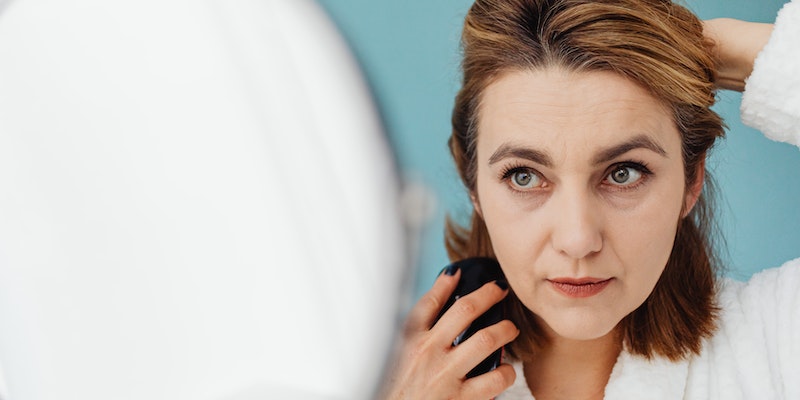Identifying Shingles: Common Signs and Symptoms
Oct 01, 2023
The chickenpox virus is also responsible for causing shingles. The chickenpox virus might remain dormant in the body and reactivate later, causing shingles. Initially, a painful rash emerges in a band or stripe pattern on one side of the body. Shingle symptoms include fever, headache, exhaustion, and photosensitivity. The skin on your face, eyes, and even internal organs can all be affected by shingles. Eye infections and other visual issues are possible side effects if it spreads to the face. Adults 50 and over can reduce their vulnerability to shingles by vaccination.
The most noticeable sign of shingles herpes is a painful rash on one side of the body, but the disease can manifest in several other ways. This illness can affect any body part, including the face and eyes. Itching, tingling, and a burning feeling are common reactions to the rash. Those who fear they have shingles should consult a doctor immediately.
Symptoms and Signs of Shingles

Some of the most common shingles symptoms include:
- Aching
- Tingling
- Pain in the spot where the rash will eventually appear
- Fever
- Headache
- Chills
- Stomach problems.
Shingles can produce mild to severe discomfort, depending on the individual.
Oral Shingles and Its Symptoms
When shingles appear inside the mouth, it is called "oral shingles." Tingling, burning, soreness, and trouble eating are all possible symptoms. It's possible to get ulcers from blisters. Most ulcers heal in about a week to two weeks. The oral shingle has symptoms:
- Damage to the mouth and teeth;
- A softening of the face
- Ache in the mouth
- Hurting teeth
- Mouth and facial blistering or rash
- Discomfort, agony, or scorching sensation in the mouth
Stages of Oral Shingles
Prodromal stage
A person may experience pain, burning, or tingling on the shingles rash region for 1–2 days before it starts. The pain before the rash might be misinterpreted for toothache, leading to needless dental operations.
An acute eruption
Rashes and fluid-filled blisters form in clusters during this period. The mouth rash may occur alone or with a facial rash. Inside the mouth, the rash can affect the upper and lower jaw, including the palate, upper or lower tooth gums, and tongue.
This phase may cause symptoms like:
- Tremendous pain
- Trouble chewing
- Appetite loss
- Mouth sensitivity
- Drooling
Afterherpetic neuralgia
Not all shingles sufferers reach this stage. A person may feel discomfort at this time. Recurrent pain may continue for four weeks or more. During this period, a person may suffer:
- Long-lasting tingling
- Burning
- Shock-like discomfort
- Jaw motions like chewing may hurt.
Shingles on Arms
If you suspect that a rash on your arm is caused by herpes zoster, you must seek medical attention to avoid potential complications associated with this virus. Important information about shingles on the arms, including prevalent symptoms, is provided below.
Symptoms of Arm Shingle
The rash typically develops in a striped pattern and is highly excruciating. In some cases, you may experience pain, tingling, burning, or irritation in the same areas of the body 1 to 2 days before the appearance of a rash.
Blisters develop on top of the dermatitis (swollen skin) and typically crust over within 7 to 10 days. Consult a reputed doctor before recovering after two to four weeks.
Moreover, zoster can cause non-skin-related symptoms similar to other viral infections. Examples include:
- A fever
- Chills
- Muscular soreness
- Gastric distress
- Irregular vomiting
- A lack of energy
- Discomfort in the head
Shingles on Fingers

Although it's not frequent, shingles can also affect the fingers. You should see a doctor as soon as possible in this condition as you use your fingers so many times a day.
Symptoms of Shingles on Fingers
The first sign of shingles is a burning or tingling ache in the fingers. Some days after the discomfort starts, a rash will form. Before the rash appears, you may also have flu-like symptoms.
Causes of Shingles on Fingers
- No one knows what causes the shingles virus to reactivate in places like the fingers and hands.
- Aging and a weak immune system have been hypothesized to have a role.
- A shingles rash can emerge anywhere on the body if the chickenpox virus is reactivated. The most effective method for preventing a shingles epidemic is to be vaccinated.
Shingles on the Face
Although the painful shingles rash is most commonly found on the upper body, it can also spread to the face, specifically the eyes. Potential symptoms include corneal irritation, redness, and blistering. Potential long-term problems include impaired eyesight.
The varicella-zoster virus can remain latent in certain people's bodies. In some people, it does not remain dormant and develops shingles. The virus can reactivate several times over an individual's lifespan.
Symptoms of Face Shingles
A person with shingles on their face may feel:
- a rash
- intensity of pain, sensitivity, or scorching
- facial muscles that are hard to move
- disabled hearing
- vertigo
- Heavy eyelids
- dental, oral, tongue, or palate issues
- issues with gustatory perception
- problems with sight, including immobility of the affected eye
Shingles on Legs
While shingles can cause a rash everywhere on the body, other causes of rashes on the inner thigh or buttocks tend to have the following symptoms.
- Reddish or brownish, a half-moon rash with tiny blisters and rough skin characterizes jock itch. It's annoying, but it's not as excruciating as shingles. A location like the groin, always wet from sweat, is particularly vulnerable to this fungal infection.
- A dry, scaly rash develops, although hives may sometimes emerge. The skin of your upper legs and groin scrapes against clothing more than everywhere else, making it susceptible to contact dermatitis.
- Prickly heat, also known as heat rash, manifests as itchy, red pimples on the skin, especially in sweaty, confined areas. Prickly heat is most frequent on your legs and groin in warm weather.
Treatments
There are several options for treating shingles and its scars:
- Therapeutic freezing.
- Surgery.
- Camouflage on the skin.
- Silicone foams or films
- Anabolic steroids.
- Therapies involving the use of lasers and other bright lights.
- Natural treatments for shingles scars like essential oils





